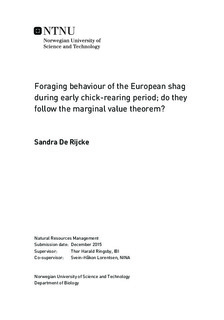| dc.description.abstract | 1. Optimal allocation of food is essential during the breeding season, when animals have to provide food for themselves and their chicks. As central place foragers, seabirds forage away from the nest and have to balance their travelling and foraging times and their food intake so that their energy gain is optimized in order to sustain for themselves and their offspring. The marginal value theorem (MVT) predicts an optimal residence time in a foraging patch in response to the rate of energy intake and travelling time to the patch.
2. The breeding performance of seabirds is closely related to the availability of food and their individual foraging performance. Thus, it is important to understand their foraging strategies in order to manage populations successfully.
3. In this study, GPS loggers (Global Positioning System) and TDR s (Time Depth Recorders) were used simultaneously to collect data on foraging behaviour of European shags Phalacrocorax aristotelis during the early chick rearing period at Sklinna, central Norway. Individual variation in foraging behaviour was investigated in accordance with the predictions of the MVT.
4. The results showed that shags foraged in a patchy habitat and that the distance to the colony was an important predictor of the time spent in the foraging patch, time spent diving and time spent resting. However, assuming that dive time is positively correlated with prey acquisition, the shags did not experience a diminishing return while foraging, which is an important assumption of the MVT.
5. The principles expressed in the MVT may govern allocation of foraging behaviour of European shags. Accordingly, factors that influence optimal foraging behaviour may have consequences for the total energy budget and their chick production, and ultimately their lifetime reproductive success. | |

